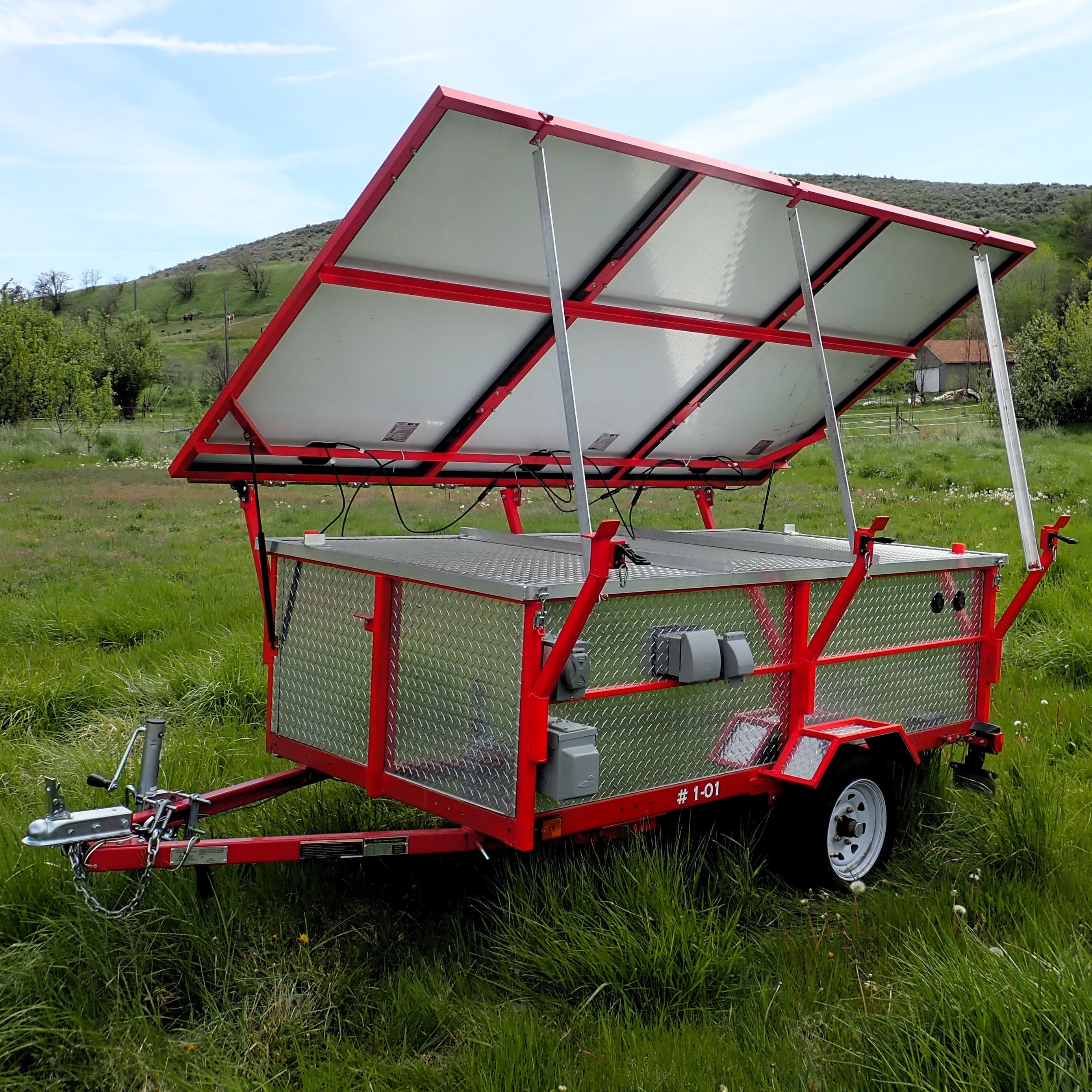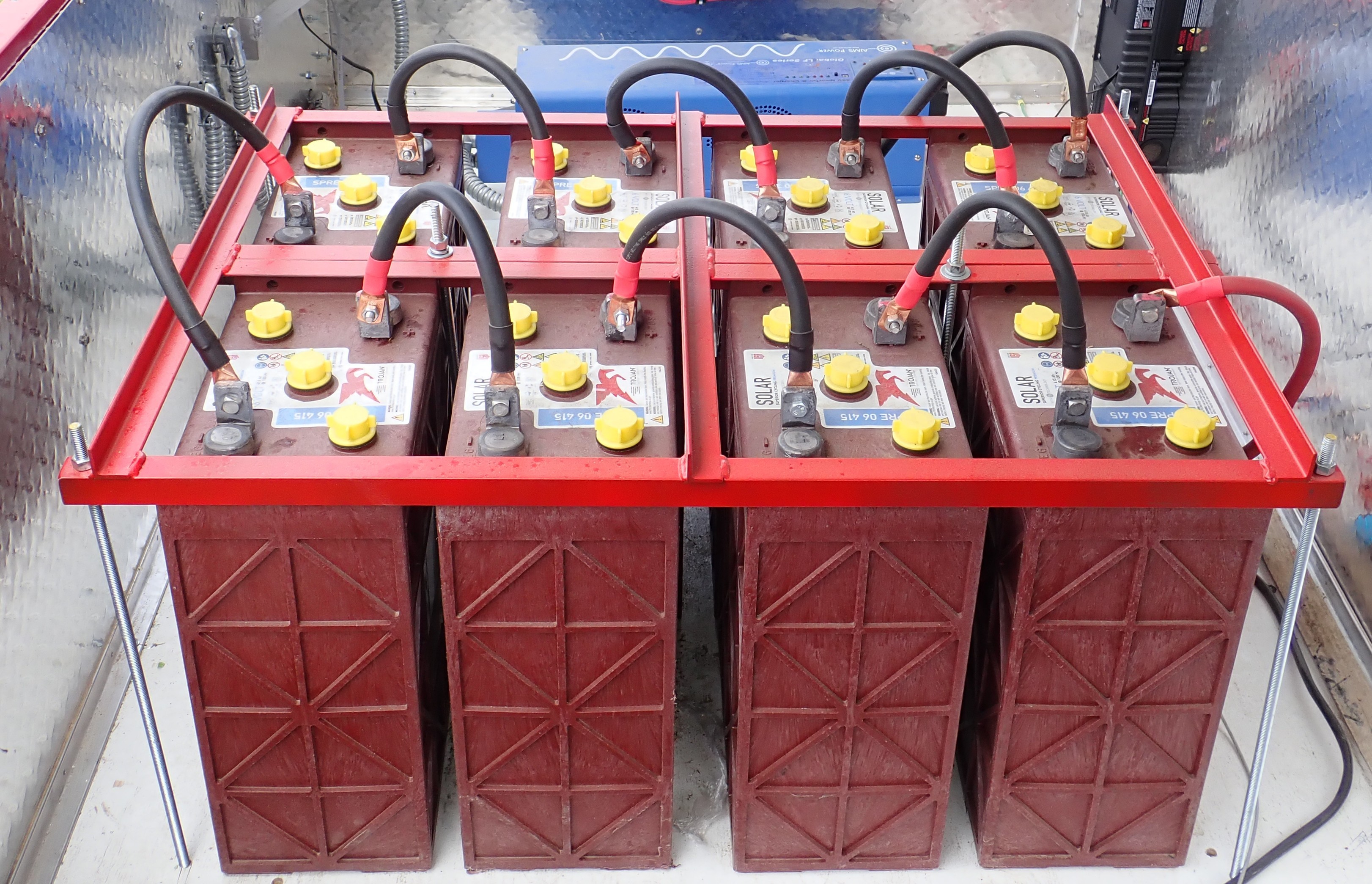Whatever you want to run, our flagship three panel trailers can run it. Inflatable movie screens at night, electric food trailers, high power welders for remote construction, or just a silent, renewable backup power supply for your home when the grid goes down - you want our three panel trailer. But even fully loaded, they’re still only around 2000 pounds - so you can tow it behind just about anything! You don’t need a big truck to move big power.
1000W of Solar
It starts with 1000W of solar panels. The panels are “always working” - even if they’re stowed flat and the trailer is in the sun, they charge. But they also tip up about 40 degrees to better capture the sun when the trailer is stationary. We’ve tested them in some pretty stiff winds, too - they’re not going anywhere!

With plenty of air around the panel, they run far cooler than the same panel would on a roof - which means more power from them. A cold panel is a happy panel!
Midnite Charge Controllers
Depending on the exact trailer model, you’ll find one of a range of Midnite Solar charge controllers mounted inside. These handle charging the battery from solar, and, like the panels, are always alive, hunting the electrons that keep the battery topped off. Pre-programmed from our factory for your specific battery pack’s needs, these MPPT (Maximum Power Point Tracking) units will find the maximum power the panels can put out and convert it down to what the battery bank needs. In the winter, the extra voltage that cold panels produce gets turned directly into more usable power to charge the batteries.
(TODO CHARGE CONTROLLER)
A large shunt serves to monitor current in and out of the battery bank for the purposes of tracking state of charge, doing amp-based charge termination, and tracking power in and out of the bank.
The Battery Bank
The central section of the trailer is filled with a large, lead acid battery bank sized for your needs, up to 20kWh. The batteries are secured in place to prevent any movement during driving. Our prototype uses flooded lead acid batteries, but production units are designed around high power density AGMs - they’re sealed, so no need for watering, no concerns about acid flooding, and even the small packs can source enough current to run just about anything! Under regular cycle life, the AGMs should have a service life of 10+ years, but for less frequent use, as long as you keep them charged, they should last longer.
We don’t use cheap, generic “deep cycle” batteries of the month. We source Trojan Solar AGMs, designed for a long service life, even with partial state of charge cycling. They’re designed for off grid, renewable energy power systems, and it shows in their performance and longevity.

The three panel trailers typically ship with a 10kWh or 20kWh 48V bank, but if you have specific requirements best met by something custom, please, reach out!
If you’re curious about why we choose lead acid over lithium, check out our FAQ.
Inverter to 240VAC (or 120VAC)
If you have big 240V split phase loads to run - welders, air conditioners, well pumps, or even just a typical home when the power’s out, we provide an Aims Power inverter that will run it. The 6kW inverter can surge up to 18kW to brute force through starting any compressor or motor you have, and can also power a range of 120V loads. Aims Power inverters are tested, abused, and approved by the off grid community. They’re not light, because they have copious amounts of copper throughout - not the cheaper aluminum wiring that some off brand inverters with similar specs might use. A remote panel allows for monitoring the inverter operation, and the charge controller’s shunt allows you to see just how much current is flowing in or out of the battery pack.
(TODO INVERTER)
If you don’t need 240V, and just need a lot of power at 120V, we can do that as well! The Midnite Solar DIY Inverter series will provide up to 5kW sustained and 7kW starting at 120V, in a lighter, less expensive package. For a remote cabin without any 240V loads, or for home backup power to the freezers, a 120V system will work just fine!
In addition to providing AC, these inverters will also rapidly charge the battery bank if you have external power available. A generator inlet plug allows you to recharge the bank when you’ve got power available - top off at the RV campsite before you head out boondocking, or just keep things charged in your garage for backup power.
If you’re not sure what you need, get in touch - we’ve worked with a range of power requirements, and can help you get your battery pack and inverter sized for your particular needs!
120V Charger
It’s raining. It’s overcast. Or it’s snowing. And you still need to run your big loads even though the sun is nothing but a faint memory. There are times when solar just doesn’t cut it - so an optional 120V charger allows you to feed power into the trailer with a small, quiet generator - while still starting your 240V loads. A small inverter generator, running quietly and efficiently, will charge the battery bank in a pinch while the big inverter will still start your well pump. We just don’t like loud generators! Obviously, this isn’t magic so it won’t run more loads than the charge rate, but being able to run big 240V loads intermittently off a small 120V generator is far quieter and cheaper than needing a big, loud, fuel hungry open frame generator just to start the motor.
12V Output and Accessories
If you have a lot of low power DC equipment to run, there’s no reason to run the big inverter when you can run your loads straight off 12V! An optional 12V converter will take DC straight off the battery pack and output 13.8V - same as a running car - to run laptops, phones, sound systems, light towers, and more.
And this is just the prototype!
But where are the 19” trailer tires? Where’s the overbuilt trailer designed for crazy mountain roads?
This is just our prototype, proving the concept and demonstrating the electrical capability. Don’t worry - this isn’t what we’re shipping, and we’ll update the photos just as soon as the production model is finished. This is our test mule, with plenty of space for experimentation. If we want to beat up a new inverter before shipping it, it goes in here first, and we only design around it once we’re happy with what it does.
Pricing
The three panel trailer starts at $15k, with actual price dependent on how much battery capacity you need and what other features you need. Unfortunately, with the way prices of our raw materials are going up (if we can even get them), it’s hard to pin down pricing ahead of time.